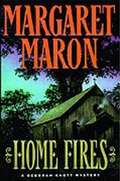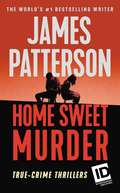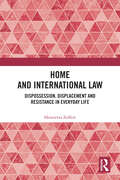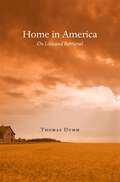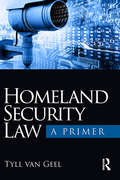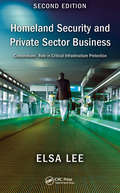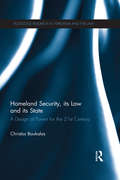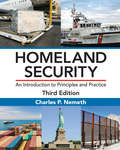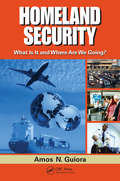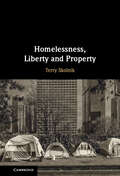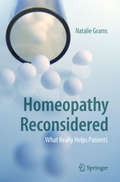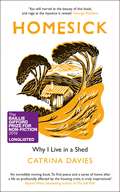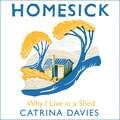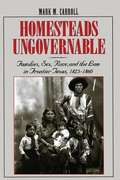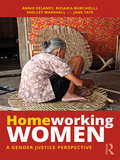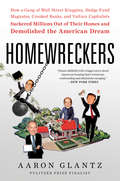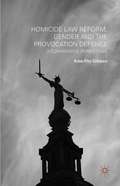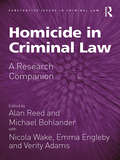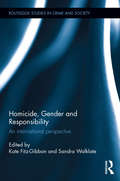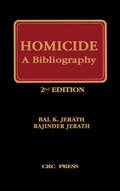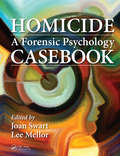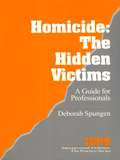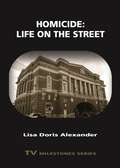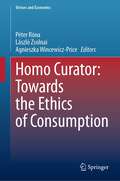- Table View
- List View
Home Fires (Deborah Knott #6)
by Margaret MaronChurches are burning all over the county and Deborah Knott must find out who is setting the fires.
Home Sweet Murder: True-crime Thrillers (ID True Crime #2)
by James PattersonAs seen on the Discovery ID TV series Murder is Forever, these two true-crime thrillers follow a lawyer struggling to stop a killer and a detective angling to solve a double homicide.Home Sweet Murder (with Andrew Bourelle): Lawyer Leo Fisher and his wife Sue are a sixty-one-year-old couple enjoying a quiet Sunday dinner at home. Until a man in a suit rings their front door claiming to be an SEC agent. By the end of the evening, two people will be shot, stabbed, and tortured. And two others will fare worse . . . Murder on the Run (with Scott Slaven): The middle-aged housekeeper found dead with a knife in her throat was bad. But the little boy was worse. After a bloody double homicide that puts Omaha, Nebraska, on the map, Detective Derek Mois promises the boy's parents he will catch the killer, no matter how long or far he runs . . .
Home and International Law: Dispossession, Displacement and Resistance in Everyday Life
by Henrietta ZeffertThis book is about home and international law. More specifically, it is about the profound, and frequently devastating, transformations of home that are happening almost everywhere in the world today and what international law has to do with them. Through three stories of home – the desert home, the lake home and the city home – this book traces how the everyday operations of international law shape the material, affective and imaginative experience of home. It argues that international law’s ‘homemaking work’ is characterised by acts of domination, practices of resistance and the production of unhomely spaces. However, the book also considers whether and how the liberatory potential of international law could be unlocked through the metaphor of home. This book draws from fieldwork conducted by the author in Palestine, Cambodia and the United Kingdom. It takes a global socio-legal approach to home and international law, informed by feminist political theory, feminist geography, home studies and contemporary critical approaches to international law. It is the first academic work to examine the relationship between home and international law. This book’s global socio-legal approach to home and international law will be of interest to those teaching and studying in international law, socio-legal studies, legal pluralism and legal geography.
Home in America: On Loss and Retrieval
by Thomas DummAmericans encounter their homes in ways comforting and haunting: as an imagined refuge or a place of mastery and domination, a destination or a place to escape. Drawing on literature, personal experience, and the histories of slavery, incarceration, and homesteading, Thomas Dumm offers a meditation on the richness and poverty of the idea of home.
Homeland Security Law and Policy
by William C. NicholsonHomeland Security Law and Policy discusses relationships abroad, the mission of federal, state, and local governments here at home, and the best way to 'provide for the common defense' in a unique and incredibly helpful way. Presented in eight sections, the first examines homeland security and emergency management, defines homeland security within the classroom and the military, FEMA's place in policy, law, and management which includes a hazardous materials perspective, FEMA's changing priorities, and the shape of emergency response and management in the aftermath of the Homeland Security Act of 2002. Section II explores the local and regional perspectives, homeland security initiatives and management in metro areas, and emerges with a strategy for security. Section III presents new partnerships for homeland security which covers the government, the private sector, and higher education. Partnering with the Department of Defense is reviewed, including their immediate response to any given disaster. Section IV covers 'civil rights' issues, the governmentís demands for new and unnecessary powers, antiterrorism investigations, the Fourth Amendment, the USA Patriot Act, money laundering, and suspicious activity reports from financial institutions. Section V explores the challenges for transportation and policy issues, aviation security, the role of technology and the federalized screening process. Section VI discusses natural disasters, weapons of mass destruction, bioterrorism defense, and the 'dirty bomb' and its policy implications. Section VII continues with foreign policy aspects and foreign views, including excerpts from President Bush and Representative Doug Bereuter (R-Nevada). The final section tackles future challenges, restructuring management, the need for a change, the future role of the FBI, the executive orders issued in response to the 9-11 Commission Report, and the 9-11 Commission Report Implication Legislation. Illustrations and photographs are included to further the understanding of the subject matter. This resource will be invaluable to all law enforcement professionals, investigators, attorneys, and policymakers as well as the general public.
Homeland Security Law: A Primer
by Tyll van GeelSince 2001 the U.S. government has been engaged in the delicate balancing act of seeking to protect the country against terrorism, both foreign-connected and wholly domestic, while taking into account a number of constitutional protections that can all too easily be trammelled in the effort to assure domestic security. At the same time the development of these policies has created significant constitutional tension among the three branches of the federal government, especially when the President vigorously asserts claims of sweeping power as commander-in-chief in such a way as to raise warnings about the emergence of an imperial presidency. Simultaneously, the rule of law has been placed under stress as the technological prowess of the government has grown. This book addresses these topics in an accessible manner, covering the key developments of domestic security law related to terrorism. Tyll van Geel covers the essential elements of homeland security law including: branches of government and institutions involved in counterterrorism law; border control and immigration; surveillance; the searching of computers and cell phones; the prosecution of terrorists for any number of crimes, including cyberterrorism; military detention; the prosecution of unprivileged enemy belligerents in military commissions; and habeas corpus. The book is designed to offer a clear guide to current issues in domestic security in response to terrorism and will be a valuable guide for concerned citizens as well as undergraduate students studying domestic politics or national security.
Homeland Security and Private Sector Business: Corporations' Role in Critical Infrastructure Protection, Second Edition
by Chi-Jen Lee Cheng-Hsiung Lu Lucia H. LeeAddressing mandates and legislation introduced since the first edition, this new edition of an essential text identifies the role the private sector plays in securing our homeland and offers strategies to aid in the fight against national and international threats. It includes updates to the NIPP (National Infrastructure Protection Plan), new case studies of both proper security policies and procedures in practice versus costly security breaches, a toolkit for improving a company‘s security posture, and new measures to assess and address vulnerabilities and threats.
Homeland Security, its Law and its State: A Design of Power for the 21st Century (Routledge Research in Terrorism and the Law)
by Christos BoukalasThis book assesses the impact of post-9/11 domestic counterterrorism policy on US political life. It examines political discourse, law, institutional architecture, and state-population relations, and shows that ‘homeland security’ is a project with wide-ranging implications for democratic institutions and culture. These implications are addressed through a novel approach that treats law and the state as social relations, and relates developments in law to those in the state and in social dynamics. On this basis, the book examines the new political representations in counterterrorism discourse, especially regarding the relation between the state and the population. It examines the form and content of counterterrorism law, the powers it provides, and the structure and functions it prescribes for the state. By focusing on the new Department of Homeland Security and the restructuring of the intelligence apparatus, the book assesses the new, intelligence-led, policing model. Finally, it examines forms of popular support and resistance to homeland security, to discuss citizenship and state-population relations. The author concludes that homeland security has turned the US into a hybrid polity; the legal and political institutions of democracy remain intact, but their content and practices become authoritarian and exclude the population from politics. These legal and political forms remain operative beyond counterterrorism, in the context of the present economic crisis. They are a permanent configuration of power. This book is an indispensable companion for students of (counter-) Terrorism and Security Studies, Politics, Human Rights, Constitutional and Criminal Law, American Studies, and Criminology.
Homeland Security: An Introduction to Principles and Practice, Third Edition
by Charles P. NemethSince formed in 2002, DHS has been at the forefront of determining and furthering some of the most hotly debated security issues facing the U.S. and global community in the 21st century. Nearly 200 university programs with undergrad and graduate majors have cropped up in the last dozen-plus years with limited resources available to teach from. Homeland Security, Third Edition will continue to serve as the core textbook covering the fundamental history, formation, oversight, and reach of DHS currently. The book is fully updated with new laws, regulations and strategies across intelligence, transportation sectors, emergency management, border security, public utilities and public health.
Homeland Security: What Is It and Where Are We Going?
by Amos N. GuioraWith the ten-year anniversary of 9/11 now behind us, one critical question persists. Have policies enacted to protect us from terrorist attacks actually made us safer, or have they merely mollified the concerned public with a false sense of security? Homeland Security: What Is It and Where We Are Going combines professional experiences, personal re
Homelessness, Liberty and Property
by Terry SkolnikIn Homelessness, Liberty and Property, Terry Skolnik establishes a novel theory about the government's duties to end homelessness, maintain public property's value, and legitimize laws that regulate public space. In doing so, Skolnik provides new insight into how the property law system and the regulation of public space limit unhoused persons' freedom and political equality. The book deepens our understanding of how various areas of law, such as constitutional law, legal philosophy, criminal law, and property law, approach the reality of homelessness and advances original arguments to provide new justifications for the right to housing. Skolnik concludes by offering a set of concrete proposals for how the government can reduce the incidence of homelessness and treat unhoused persons with greater concern and respect. This title is part of the Flip it Open Programme and may also be available open access. Check our website Cambridge Core for details.
Homeopathy Reconsidered: What Really Helps Patients
by Natalie GramsHomeopathy is over 200 years old and is still experiencing an uninterrupted influx of new practitioners and patients. Many patients and therapists swear by this "alternative healing method", which in some countries is even financed by health insurances. This seems completely incomprehensible to critics: For them it is clearly evident that homeopathy is hopelessly unscientific and has at best a placebo effect. The positions of supporters and opponents seem to be just as immutable as they are incompatible. This book answers some essential and fascinating questions: What remains of the founding ideas of homeopathy in 21st century medicine? Does it really work and, if so, how? Which of the original theories can we still apply today with a clear conscience and use for the benefit of patients and the healthcare system? Where does homeopathy have its limits and does it indeed need to be critically reconsidered and evaluated? The author has dealt with the points of criticism for years, but at the same time also takes seriously the wishes and concerns of patients who often feel insufficiently cared for by conventional medical practice. Against the background of her own personal history, her book attempts to bridge the gap between these two traditionally opposing camps.
Homesick: Why I Live in a Shed
by Catrina DaviesThe story of a personal housing crisis that led to a discovery of the true value of home.*LONGLISTED FOR THE BAILLIE GIFFORD PRIZE**'You will marvel at the beauty of this book, and rage at the injustice it reveals' George Monbiot**'Incredibly moving. To find peace and a sense of home after a life so profoundly affected by the housing crisis, is truly inspirational' Raynor Winn, author of The Salt Path*Aged thirty-one, Catrina Davies was renting a box-room in a house in Bristol, which she shared with four other adults and a child. Working several jobs and never knowing if she could make the rent, she felt like she was breaking apart. Homesick for the landscape of her childhood, in the far west of Cornwall, Catrina decides to give up the box-room and face her demons. As a child, she saw her family and their security torn apart; now, she resolves to make a tiny, dilapidated shed a home of her own.With the freedom to write, surf and make music, Catrina rebuilds the shed and, piece by piece, her own sense of self. On the border of civilisation and wilderness, between the woods and the sea, she discovers the true value of home, while trying to find her place in a fragile natural world.This is the story of a personal housing crisis and a country-wide one, grappling with class, economics, mental health and nature. It shows how housing can trap us or set us free, and what it means to feel at home.
Homesick: Why I Live in a Shed
by Catrina DaviesThe story of a personal housing crisis that led to a discovery of the true value of home.*'You will marvel at the beauty of this book, and rage at the injustice it reveals' George Monbiot**'Incredibly moving. To find peace and a sense of home after a life so profoundly affected by the housing crisis, is truly inspirational' Raynor Winn, bestselling author of The Salt Path*Aged thirty-one, Catrina Davies was renting a box-room in a house in Bristol, which she shared with four other adults and a child. Working several jobs and never knowing if she could make the rent, she felt like she was breaking apart. Homesick for the landscape of her childhood, in the far west of Cornwall, Catrina decides to give up the box-room and face her demons. As a child, she saw her family and their security torn apart; now, she resolves to make a tiny, dilapidated shed a home of her own.With the freedom to write, surf and make music, Catrina rebuilds the shed and, piece by piece, her own sense of self. On the border of civilisation and wilderness, between the woods and the sea, she discovers the true value of home, while trying to find her place in a fragile natural world.This is the story of a personal housing crisis and a country-wide one, grappling with class, economics, mental health and nature. It shows how housing can trap us or set us free, and what it means to feel at home.This audio edition includes music by Catrina Davies.(P)2019 Quercus Editions Limited
Homesteads Ungovernable: Families, Sex, Race, and the Law in Frontier Texas, 1823-1860
by Mark M. CarrollWhen he settled in Mexican Texas in 1832 and began courting Anna Raguet, Sam Houston had been separated from his Tennessee wife Eliza Allen for three years, while having already married and divorced his Cherokee wife Tiana and at least two other Indian "wives" during the interval. Houston's political enemies derided these marital irregularities, but in fact Houston's legal and extralegal marriages hardly set him apart from many other Texas men at a time when illicit and unstable unions were common in the yet-to-be-formed Lone Star State.<P>In this book, Mark Carroll draws on legal and social history to trace the evolution of sexual, family, and racial-caste relations in the most turbulent polity on the southern frontier during the antebellum period (1823-1860). He finds that the marriages of settlers in Texas were typically born of economic necessity and that, with few white women available, Anglo men frequently partnered with Native American, Tejano, and black women. While identifying a multicultural array of gender roles that combined with law and frontier disorder to destabilize the marriages of homesteaders, he also reveals how harsh living conditions, land policies, and property rules prompted settling spouses to cooperate for survival and mutual economic gain. Of equal importance, he reveals how evolving Texas law reinforced the substantial autonomy of Anglo women and provided them material rewards, even as it ensured that cross-racial sexual relationships and their reproductive consequences comported with slavery and a regime that dispossessed and subordinated free blacks, Native Americans, and Tejanos.
Homeworking Women: A Gender Justice Perspective
by Shelley Marshall Annie Delaney Rosaria Burchielli Jane TateHomework; work that is categorised as informal employment, performed in the home, mainly for subcontractors and mostly undertaken by women. The inequities and injustices inherent in homework conditions maintain women’s weak bargaining position, preventing them from making any improvements to their lives via their work. The best way to tackle these issues is not to abolish, but to bring equality and justice to homework. This book contributes a gender justice framework to analyse and confront the issues and problems of homework. The authors propose four justice dimensions – recognition, representation, rights and redistribution – to examine and analyse homework. This framework also takes into account the structures and processes of capitalism and the patriarchy, and the relations of domination that are widely held to be the major factors that determine homework injustice. The authors discuss strategies and approaches that have worked for homeworkers, highlighting why they worked and the features that were beneficial for them. Homeworking Women will be of interest to individuals and organisations working with or for the collective benefit of homeworkers, academics and students interested in feminism, labour regulation, informal work, supply chains and social and political justice.
Homewreckers: How a Gang of Wall Street Kingpins, Hedge Fund Magnates, Crooked Banks, and Vulture Capitalists Suckered Millions Out of Their Homes and Demolished the American Dream
by Aaron GlantzIn the spirit of Evicted, Bait and Switch, and The Big Short, a shocking, heart-wrenching investigation into America’s housing crisis and the modern-day robber barons who are making a fortune off the backs of the disenfranchised working and middle class—among them, Donald Trump and his inner circle. Two years before the housing market collapsed in 2008, Donald Trump looked forward to a crash: “I sort of hope that happens because then people like me would go in and buy,” he said. But our future president wasn’t alone. While millions of Americans suffered financial loss, tycoons pounced to heartlessly seize thousands of homes—their profiteering made even easier because, as prize-winning investigative reporter Aaron Glantz reveals in Homewreckers, they often used taxpayer money—and the Obama administration’s promise to cover their losses. In Homewreckers, Glantz recounts the transformation of straightforward lending into a morass of slivered and combined mortgage “products” that could be bought and sold, accompanied by a shift in priorities and a loosening of regulations and laws that made it good business to lend money to those who wouldn’t be able to repay. Among the men who laughed their way to the bank: Trump cabinet members Steve Mnuchin and Wilbur Ross, Trump pal and confidant Tom Barrack, and billionaire Republican cash cow Steve Schwarzman. Homewreckers also brilliantly weaves together the stories of those most ravaged by the housing crisis. The result is an eye-opening expose of the greed that decimated millions and enriched a gluttonous few.
Homicide Law Reform, Gender and the Provocation Defence
by Kate Fitz-GibbonThis book critically examines the operation of the partial defence of provocation in a range of comparative international jurisdictions. Centrally concerned with conceptual questions of gender, justice and the role of denial in the criminal justice system, Fitz-Gibbon explores the divergent approaches taken to reforming the law of provocation.
Homicide in Criminal Law: A Research Companion (Substantive Issues in Criminal Law)
by Alan Reed Michael BohlanderThis volume presents a leading contribution to the substantive arena relating to homicide in the criminal law. In broad terms, the ambit of homicide standardisations in extant law is contestable and opaque. This book provides a logical template to focus the debate. The overall concept addresses three specific elements within this arena, embracing an overarching synergy between them. This edifice engages in an examination of UK provisions, and in contrasting these provisions against alternative domestic jurisdictions as well as comparative contributions addressing a particularised research grid for content. The comparative chapters provide a wider background of how other legal systems treat a variety of specialised issues relating to homicide in the context of the criminal law. The debate in relation to homicide continues apace for academics, practitioners and within the criminal justice system. Having expert descriptions of the wider issues surrounding the particular discussion and of other legal systems’ approaches serves to stimulate and inform that debate. This collection will be a major source of reference for future discussion.
Homicide, Gender and Responsibility: An International Perspective (Routledge Studies in Crime and Society)
by Sandra Walklate Kate Fitz-GibbonThe crime of homicide has long animated academic debate, community concern and political attention. The discussion has often centered on the perceived (in)adequacy of legal responses to homicide, questions of culpability, and divergent representations of victims and offenders. Within this, notions of gender, responsibility and justice are pivotal. This edited collection builds on existing scholarship by examining these concerns not only in the context of the ‘private’ world of domestic murder but also in the more ‘public’ world of the state, the corporation, war, and genocide. In so doing this book draws from key frameworks of criminological thought, legal analysis and empirical evidence to critically examine the relationship between homicide, gender and responsibility. Bringing together leading international criminology and legal scholars, this collection provides a unique contribution to the academic and policy engagement with what is, more often than not, an ordinary and mundane crime. Analysing the crime in a variety of different social contexts alongside an in-depth and critical analysis of the interconnections between the ordinary act of lethal violence, gender and notions of responsibility, this book will be of interest to students, scholars and policymakers working in criminology and socio-legal studies.
Homicide: A Bibliography, Second Edition
by Bal K. Jerath Rajinder JerathHomicide represents the result of an exhaustive search of the world literature regarding homicide. More than 7,000 entries have been compiled from references selected from major indexes in libraries from outstanding universities, government agencies, and military posts; science libraries; law libraries; and the Library of Congress. Each entry features a one- or two-word annotation that indicates whether it is an article or a book, and all entries conform to the American Psychological Association stylebook guidelines. Key-word and author indexes provide quick access to works pertaining to particular subjects or by a certain author.
Homicide: A Forensic Psychology Casebook
by Joan Swart and Lee MellorForensic psychology plays an increasingly important role in criminal investigations and legal decision-making. Homicide: A Forensic Psychology Casebook guides readers through the practical aspects of homicide cases across the entire criminal justice system, from the investigative process to the criminal trial process, and beyond. Each chapter contains a description and analysis of selected cases and offenders, and provides a crime narrative and offender narrative to illustrate the underlying theory and practical considerations of homicide investigations. Criminal justice students and practitioners alike will benefit from the comprehensive scope of this text. In order to ensure fair and efficient criminal justice practices in the field of forensic investigation, there is still a need for conformity and standardization of sound protocols and approaches based on improved knowledge and education. This book is part of that effort to understand homicidal behavior and offenders better in order to prevent similar crimes.
Homicide: A Guide for Professionals
by Deborah SpungenThe author of this groundbreaking volume is not only a social scientist and victim advocate; she is also the mother of a murder victim. Deborah Spungen illustrates how and why family members become co-victims when a loved one is murdered, and she poignantly addresses the emotional, physical, spiritual and psychological effects of such traumatic events. These "invisible victims" often find their wounds compounded by confusion and a sense of aloneness in the aftermath of such a tragic event. The author draws on research, personal insight and case examples to illuminate critical issues that surround: family notification of a loved one's murder, effects of murder on family and friends of the victim, media influences, traumatic grief, circumstantial influences, the criminal justice system and reconstruction and healing. The book will be invaluable for mental health practitioners and victim advocates.
Homicide: Life on the Street (TV Milestones Series)
by Lisa Doris AlexanderRenowned for its unique visual style, Homicide: Life on the Street fundamentally changed the police procedural genre. The show broke records, featured memorable characters, and launched careers--most notably that of David Simon, whose own nonfiction book, Homicide: A Year on the Killing Streets, inspired the series, and who went on to create both The Wire and Treme. Homicide was an anomaly in the 1990s for its honest and open portrayals and discussions of race, and in this TV Milestone, Lisa Doris Alexander uses Critical Race Theory as a lens to highlight how the show illustrated the impacts that racial politics can have on policing. Homicide is one in a long line of police procedurals that date back to the early days of broadcast television, with series such as Dragnet (NBC 1951–59), Hawaii Five-O (CBS 1968–80), and Columbo (NBC 1971–78). But because Homicide takes place and was filmed in the majority-Black city of Baltimore, it makes sense that many of the main and supporting cast are Black. This differentiated it from the other shows of its genre and time. Chapter 1 discusses the Black-starring roles on Homicide in terms of being non-stereotypical and both written and performed as well-rounded, complex characters. Chapter 2 focuses on issues of race and racism and their impact on policing. Chapter 3 looks at other power dynamics, such as class, political clout, and social standing, and how those dynamics intersect with race and the criminal justice system’s perceived neutrality. In many regards, Homicide was ahead of its time. Alexander argues that Homicide reflects the politics of the Black Lives Matter movement, which in turn highlights the fact that the issues brought up by the movement are long-standing and that the series affirms the critiques BLM activists make about the criminal justice system. This book shows that the series’ oftentimes unflinching commentary on the systemic flaws within the criminal justice system not only feels more at home in today’s television and political landscape than it did in the 1990s but is just as relevant. Fans of the works of David Simon, as well as students and scholars of television studies and Critical Race Theory, will enjoy this enlightening book.
Homo Curator: Towards the Ethics of Consumption (Virtues and Economics #8)
by László Zsolnai Agnieszka Wincewicz-Price Péter RónaThis book explores the under-researched sources of the consumerist culture and the environmental damage it has brought about. The book is an outcome of the symposium on “The Ethics of Consumption” organised and hosted by the Las Casas Institute at the Blackfriars Hall, University of Oxford as part of its Economics as a Moral Science Programme. It takes on two contemporary problems: the human weakness and capacity for wrong-doing, and the failure of modern economic theory to account for the moral character of human behaviour and its implicit encouragement of gluttonous life-styles. In a time when grand political schemes are proposed to revive sustainability of global economy, the authors of the papers collected in this book highlight the need for moral renewal without which the most revolutionary structural reforms are bound to fail at producing the desired outcome. Topics of the book include the meaning and sources of avarice, the attempt to define what is enough, exploration of philosophical and theological perspectives which can serve as building blocks for the ethics of consumption. This makes the book of great interest to a broad readership of economists, social scientists and philosophers.
